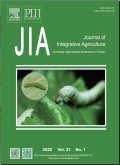首页|期刊导航|Journal of Integrative Agriculture|The microbial community,nutrient supply and crop yields differ along a potassium fertilizer gradient under wheat-maize double-cropping systems
The microbial community,nutrient supply and crop yields differ along a potassium fertilizer gradient under wheat-maize double-cropping systems
Zeli Li Fuli Fang Liang Wu Feng Gao Mingyang Li Benhang Li Kaidi Wu Xiaomin Hu Shuo Wang Zhanbo Wei Qi Chen Min Zhang Zhiguang Liu
Journal of Integrative Agriculture2024,Vol.23Issue(10):P.3592-3609,18.
Journal of Integrative Agriculture2024,Vol.23Issue(10):P.3592-3609,18.DOI:10.1016/j.jia.2024.01.031
The microbial community,nutrient supply and crop yields differ along a potassium fertilizer gradient under wheat-maize double-cropping systems
摘要
关键词
potassium fertilizer gradient/microbial community/wheat-maize double cropping/climate change/yield分类
农业科学引用本文复制引用
Zeli Li,Fuli Fang,Liang Wu,Feng Gao,Mingyang Li,Benhang Li,Kaidi Wu,Xiaomin Hu,Shuo Wang,Zhanbo Wei,Qi Chen,Min Zhang,Zhiguang Liu..The microbial community,nutrient supply and crop yields differ along a potassium fertilizer gradient under wheat-maize double-cropping systems[J].Journal of Integrative Agriculture,2024,23(10):P.3592-3609,18.基金项目
funded by the National Key Research and Development Program of China(2023YFD150050504) (2023YFD150050504)
the Key Research and Development Program of Shandong Province,China(2022SFGC0301) (2022SFGC0301)
the Strategic Priority Research Program of the Chinese Academy of Sciences-Development and Application Technology of Special Package Fertilizer for Improving Albic Soil(XDA28100203)。 (XDA28100203)

